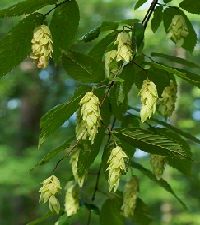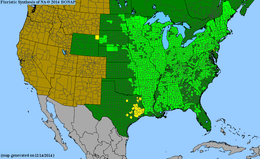Eastern hophornbeam is a slender, deciduous tree in the birch family. It is a slow-growing, small to medium understory tree, reaching 10–15' tall over 14 years. The spiky catkin flowers appear in early spring at the same time as the tree's new leaves. Pollinated female flowers develop into fruits that loosely resemble the hops used in making beer. Small nutlets are enclosed within overlapping inflated sacs that later turn from green to brown. Easy to grow in most soils. Does not demand much light and prefers a partial to deep shade. Tolerates drought and heavy clay soils, making it low maintenance and well-suited for urban settings. The showy, shaggy bark provides winter interest. Can be planted in a lawn, along a driveway, street, or in a woodland garden, but does not tolerate salt.
Eastern hophornbeam is native to eastern North America, from Nova Scotia west to southern Manitoba and eastern Wyoming, southeast to northern Florida and southwest to eastern Texas. It is found in lowland and foothill forests, where it is predominantly an understory tree. The buds and catkins are an important source of winter food for some birds. Birds, deer, and rabits eat the nutlets and buds. Resistant to insects (except gypsy moths).
BONAP Native Range Map (bright green indicates county native, dark green indicates state native).


